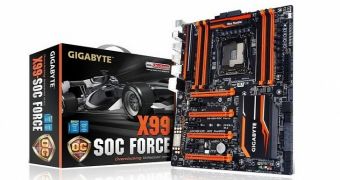You would have been excused for thinking that the X99 Gaming G1 was the only LGA 2011-3 motherboard that Gigabyte had prepared, but a new report will probably disavow you of that notion.
You see, there is a second high-end, overclocking-friendly motherboard on the way, one that bears the name of Gigabyte X99-SOC Force, from the X99 chipset that Intel put together.
The LGA 2011-3 socket is a revision of the original LGA 2011 that is not backwards-compatible with any Ivy Bridge-E or Sandy Bridge-E extreme-performance central processing units.
Instead, it only supports the Haswell-E range of chips, the Core i7-5960X, Core i7-5930K, and Core i7-5820K that Intel will launch this fall. We still don't know exactly when the introduction will take place, but it probably won't be at IFA 2014 (early September).
Either way, X99 chipset-based platforms will precede the CPUs, so we could trust a hope that this Gigabit X99-SOC Force will ship by the end of September or Early October.
According to a report, the motherboard's CPU socket is wired to no fewer than eight DDR4 DIMM memory slots.
Also, there are four PCI Express 3.0 x16 slots, allowing for massively powerful quad-SLI (NVIDIA) and quad-CrossFire (AMD) multi-GPU configurations.
A 20 Gbps M/2 slot is available as well, for truly fast solid state drives. You'll get the best out of your 1.8 GB/s M.2 SSD, thanks to the port being wired through the PCI Express 2.0 x4 physical layer, rather than SATA technology.
Speaking of SATA, there is a SATA Express 10 Gbps port as well, plus ten SATA 6.0 Gbps connectors for normal HDDs and SSDs.
Other specs include Gigabyte's own AmpUP audio tech (high-end capacitors, ground-layer isolation, and user-replaceable OPAMP chips) and onboard clock and voltage tuning buttons, plus redundant UEFI dual-BIOS and voltage measurement points.
Everything gets power through 24-pin ATX, 8-pin EPS, and SATA power connectors. An 8+2+2 phase VRM powers the CPU socket, in case you were wondering. You'll be able to overclock the living lights out of any CPU unlucky enough to land in your hands.
Unfortunately, no one bothered informing us or anyone else of the price that the Gigabyte X99-SOC Force will sport once it finally comes out, whenever that will be. Alas.
Not that it will matter as much as people think. Those with money concerns probably won't even look twice at this thing, since buying it would also demand getting top-end hardware in everything else, up to 64 GB of DDR4 even (or 128 GB if you're feeling adventurous). There's a reason only professionals acquire or build workstations of this caliber.

 14 DAY TRIAL //
14 DAY TRIAL //